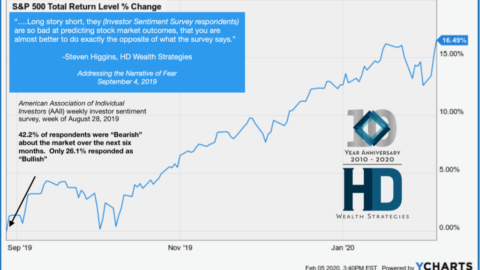A Time to Prepare: Part 1
Calm Markets Provide an Opportunity
2021 Q4 Market Commentary
By: Steven Higgins, Financial Advisor, Principal

Somehow, we find ourselves already in the fourth quarter of 2021. In what was billed as the “anything but 2020” year, we have seen continued gains in stocks as the recovery has been emboldened by household liquidity, accommodative policies, and continued (albeit tempered) optimism about the economy. As we expected, bonds have struggled in the face of increasing inflation and rising interest rates. There seems to be a lack of consensus about how willing or able policy makers are to move quickly to stave off inflation by reducing how much life support is given to an economy that in some aspects is stronger and running hotter than pre-pandemic levels. The steel of decision makers will be tested as the risks are weighed between being too slow and thus letting inflation run too hot, or being too fast and impeding the recovery before we reach a higher level of certainty about how long the COVID-19 pandemic will last.
History tells us that threading the economic needle will prove to be quite difficult and as markets digest the adjustments, there will be periods of volatility. September proved to be a sample of what is likely to come. September was only the second negative month for stocks in 2021 (January was the other). Investors, nervous about the prospects of a “fed taper,” were indecisive as the market whipsawed between positive and negative. In our option, this behavior is likely to continue for a while even as stock markets once again flirt with all-time high marks.
Taking a perspective with a bit more altitude, we find ourselves by any definition squarely in a bull market. You may be asking yourself, what exactly is a bull market? Great question: a bull market can be defined in many ways but is generally characterized as a condition or environment rather than by a metric. When markets are generally rising and investors feel motivated to buy, you’ve got a bull market. Bear markets are easier to define. When the stock market drops by 20% or more you are in a bear market. That being said, bull markets are the norm and bear markets are the exception. Since 1942, there have been thirteen bull markets averaging 4.4 years in length, with an average cumulative total return of 154%. So, considering the averages, it is possible that we are just getting started. Remember though, bull markets are fraught with volatility and never will there be a moment when there isn’t something worrisome looming on the horizon. There are certainly going to be periods of angst, but history shows markets often have the ability to “climb the wall of worry” as investopedia.com describes: the stock market’s “resilience when running into a temporary stumbling block rather than a permanent impediment to a market advance.”
Going forward, investors need to reconcile their fears and their goals. As my partner Allison Schmidt lays out in her article “Removing Emotion from the Investment Process,” we have a process to navigate through volatility rather than attempt to avoid it altogether. By having a planning-centric relationship with our clients, we are entirely focused on meeting established goals and objectives. In that spirit, attempting to try to perform the impossible by timing the short-term temperament of the market doesn’t make sense. As Allison Schmidt describes, our process includes tactical rebalancing thresholds that are triggered when the market is experiencing significant downside volatility. We also give credence to economic realities and position portfolios to best navigate macro trends such as those we face today: inflation and rising interest rates. As inflation flows through more and more layers of our economy, it’s becoming apparent that the increase in prices is not quite as temporary as decision makers thought it might be. Recently, the Social Security Administration announced a cost of living adjustment to Social Security benefits of 5.9% – the largest increase in about 40 years.* As inflation rises, the natural reaction in the world of financial physics is for interest rates to rise and conversely, bond prices to fall. The longer the maturity of a bond, the more pronounced the drop in value. We have consistently made efforts to reduce exposure to interest rate sensitive assets in our portfolios while simultaneously creating positive correlation to inflation. In short, we are investing our clients’ assets to help ensure that their investments are able to produce a rising income stream that will meet their income goals and expectations established through our planning process.
It is in these moments that investors should take the time to have conversations about their goals and expectations with qualified financial advisors. While investable assets are the engine that drives an investor’s ability to meet financial goals, it is the planning process that keeps the investments aligned with goals and expected outcomes. Investor’s memories tend to be short and emotions often creep into the consciousness of even seasoned investors. By adhering to a planning and goal centric strategy, an investor will be substantially better suited to manage and possibility benefit from the short-term tantrums in the market. At Higgins & Schmidt, we believe resilience is emboldened by preparation, so as the winds are calm and the skies are blue, prepare we shall.
Securities offered through LPL Financial, Member FINRA/SIPC. Investment advice offered through Higgins & Schmidt Wealth Strategies, a registered investment advisor and separate entity from LPL Financial. The opinions voiced in this material are for general information only and are not intended to provide specific advice or recommendations for any individual. All performance referenced is historical and is no guarantee of future results. There is no guarantee that a diversified portfolio will enhance overall returns or outperform a non-diversified portfolio. Diversification and asset allocation does not ensure a profit or protect against a loss. Stock investing involves risk including loss of principal. Bonds are subject to market and interest rate risk if sold prior to maturity. Bond values will decline as interest rates rise and bonds are subject to availability and change in price. Rebalancing a portfolio may cause investors to incur tax liabilities and/or transaction costs and does not assure a profit or protect against a loss.









